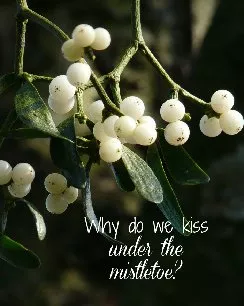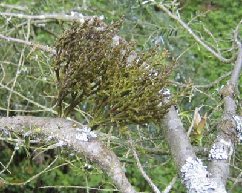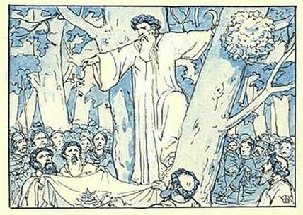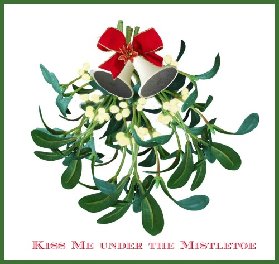View Other Topics.
 Dec 22, 2016
Dec 22, 2016
Why do we kiss under the Mistletoe? In this article from alwaystheholidays.com we find out.
We all love to kiss under the mistletoe at Christmas. But have you ever wondered why? Isn't it an oddity that a parasite plant, such as mistletoe, has come to be associated with an established tradition of kissing at holiday time? This practice is not a newly discovered way to show affection. It has actual roots in history.
Mistletoe is considered a parasite plant. It lives off of other growing plants and trees. Since the plant mistletoe has no actual roots, it finds its way onto logs and trees and forms roots there, staying green in the wintertime, even when the host plant is often bare-limbed. The birds find the berries enticing and they are quite sticky. If they get some stuck on their beaks, they will rub against trees to remove them, and a host is born.

Mistletoe growing in a tree - EarthSanctuary.com
The history of the use of mistletoe in folk lore dates back to the Druids. They considered it a sacred plant and it was used in many of their rituals. They believed that mistletoe had mystical powers and held the soul of the host tree.

Druids picking mistletoe - Mistletoe.org.uk
Kissing under the Mistletoe originated with the Roman festival of Saturnalia, the festival or celebration of Saturn. Just like at Christmas now, kissing under the mistletoe started with the onset of Saturnalia.

Invitation - alwaystheholidays.com
Mistletoe was believed to have specific powers. It was hung on stable doors to ward off evil spirits, and also on home doorways since it was considered a symbol of fertility. In fact, throughout the middle ages, mistletoe was banned by the churches because of this belief in its fertility (and the frivolousness that goes along with it!)
.jpg)
Victorians under the mistletoe - ClipartPanda.com
There is hardly a mention of mistletoe in literature in England until the 18th century. But after this, and particularly in Victorian England in the 19th century, the mention of it flourished all over Europe.
There were specific rules to this tradition in England. The gentleman would pluck one white berry while kissing the lady on the cheek. One kiss is allowed for each berry. When the berries were done, the tradition was finished. If a girl refused to kiss, it was said that she should not expect any marriage proposals for at least the next year!
.jpg)
Washington Irving - Wikipedia
Washington Irving, in Christmas Eve, even told of the typical festivities surrounding the Twelve Days of Christmas, including kissing under the mistletoe. Irving says: “The mistletoe is still hung up in farm-houses and kitchens at Christmas, and the young men have the privilege of kissing the girls under it, plucking each time a berry from the bush. When the berries are all plucked the privilege ceases.”

Christmas in the British Army - TheWarof1812.com.
The Victorians took the mistletoe kissing to a new level with their “kissing balls, ” many of which were quite elaborate. And the practice was not limited to the gentry. It was widespread with common people too.

Saturday Evening Post December 1900 - Wikipedia
The practice has continued into modern day. This cover from the Saturday Evening Post shows how we often used mistletoe today, with a single sprig over a woman’s head being enough to initiate the kiss. Often the man holds it himself!
We moderns have conveniently forgotten the part about plucking the berries (which, incidentally, are poisonous), and also from the stopping from kissing under the mistletoe when the berries run out, since it is so much more fun to continue!

Victorian Christmas - vintagechristmas.com
Is mistletoe a part of your Christmas tradition? - alwaystheholidays.com
Tags:
#mistletoe,#christmas#tradition,#the#kissing#planet,#druids,#saturnalia,#washington#irving,#victorian,#starzpsychics.com,#starz#advisors
The History of Mistletoe – The Kissing Plant.

Why do we kiss under the Mistletoe? In this article from alwaystheholidays.com we find out.
We all love to kiss under the mistletoe at Christmas. But have you ever wondered why? Isn't it an oddity that a parasite plant, such as mistletoe, has come to be associated with an established tradition of kissing at holiday time? This practice is not a newly discovered way to show affection. It has actual roots in history.
Mistletoe is considered a parasite plant. It lives off of other growing plants and trees. Since the plant mistletoe has no actual roots, it finds its way onto logs and trees and forms roots there, staying green in the wintertime, even when the host plant is often bare-limbed. The birds find the berries enticing and they are quite sticky. If they get some stuck on their beaks, they will rub against trees to remove them, and a host is born.

Mistletoe growing in a tree - EarthSanctuary.com
The history of the use of mistletoe in folk lore dates back to the Druids. They considered it a sacred plant and it was used in many of their rituals. They believed that mistletoe had mystical powers and held the soul of the host tree.

Druids picking mistletoe - Mistletoe.org.uk
Kissing under the Mistletoe originated with the Roman festival of Saturnalia, the festival or celebration of Saturn. Just like at Christmas now, kissing under the mistletoe started with the onset of Saturnalia.

Invitation - alwaystheholidays.com
Mistletoe was believed to have specific powers. It was hung on stable doors to ward off evil spirits, and also on home doorways since it was considered a symbol of fertility. In fact, throughout the middle ages, mistletoe was banned by the churches because of this belief in its fertility (and the frivolousness that goes along with it!)
.jpg)
Victorians under the mistletoe - ClipartPanda.com
There is hardly a mention of mistletoe in literature in England until the 18th century. But after this, and particularly in Victorian England in the 19th century, the mention of it flourished all over Europe.
There were specific rules to this tradition in England. The gentleman would pluck one white berry while kissing the lady on the cheek. One kiss is allowed for each berry. When the berries were done, the tradition was finished. If a girl refused to kiss, it was said that she should not expect any marriage proposals for at least the next year!
.jpg)
Washington Irving - Wikipedia
Washington Irving, in Christmas Eve, even told of the typical festivities surrounding the Twelve Days of Christmas, including kissing under the mistletoe. Irving says: “The mistletoe is still hung up in farm-houses and kitchens at Christmas, and the young men have the privilege of kissing the girls under it, plucking each time a berry from the bush. When the berries are all plucked the privilege ceases.”

Christmas in the British Army - TheWarof1812.com.
The Victorians took the mistletoe kissing to a new level with their “kissing balls, ” many of which were quite elaborate. And the practice was not limited to the gentry. It was widespread with common people too.

Saturday Evening Post December 1900 - Wikipedia
The practice has continued into modern day. This cover from the Saturday Evening Post shows how we often used mistletoe today, with a single sprig over a woman’s head being enough to initiate the kiss. Often the man holds it himself!
We moderns have conveniently forgotten the part about plucking the berries (which, incidentally, are poisonous), and also from the stopping from kissing under the mistletoe when the berries run out, since it is so much more fun to continue!

Victorian Christmas - vintagechristmas.com
Is mistletoe a part of your Christmas tradition? - alwaystheholidays.com
Share this article with friends!
Tags:
#mistletoe,#christmas#tradition,#the#kissing#planet,#druids,#saturnalia,#washington#irving,#victorian,#starzpsychics.com,#starz#advisors






